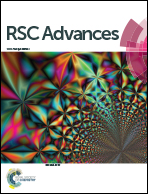Morphology-controlled synthesis of WO2.72 nanostructures and their photocatalytic properties†
Abstract
The morphologies of nanomaterials have great influence on their properties. In this work, we used the solvothermal method to prepare tungsten oxides with two different morphologies: WO2.72 nanowires and urchin-like WO2.72 nanostructures. The photocatalytic activities of these two bare WO2.72 nanostuctures were evaluated by their efficiency in the degradation of pollutants, during which the influence of the morphology was taken into account. In the experiments, material structures and oxygen vacancies were altered with the change of the morphology. One-dimensional WO2.72 nanowires with fewer oxygen vacancies showed higher photocatalytic activity than three-dimensional urchin-like WO2.72 nanostructures with more oxygen vacancies. Thus, we ascertained the prominent role of the structure, rather than the number of oxygen vacancies, in enhancing photocatalytic activity. Surface photocurrent (SPC) measurements further confirmed that WO2.72 nanowires were more conducive to photo electron transfer than urchin-like WO2.72 nanostructures, which corresponded with the results of photocatalysis. Compared with commercial nanostructured tungsten oxide, both the WO2.72 nanowires and urchin-like WO2.72 nanostructures exhibited enhanced photocatalytic activities for the degradation of pollutants under UV light irradiation.


 Please wait while we load your content...
Please wait while we load your content...